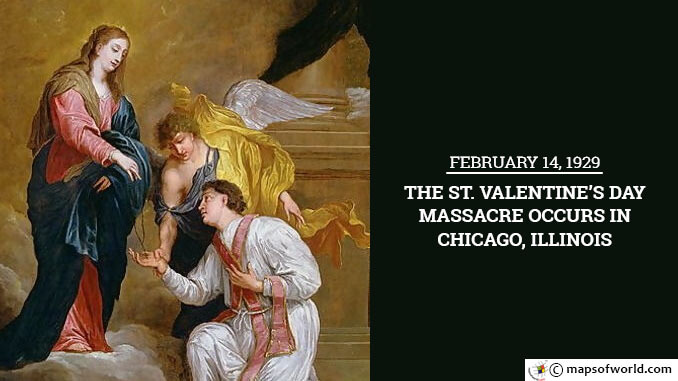The St. Valentine’s Day Massacre of February 14, 1929 in Chicago, Illinois, left seven rivals of gangster Al Capone dead, making him the undisputed leader of the city’s underworld. The ongoing rivalry between the South Side Chicago’s Italian gang led by Al “Scarface” Capone and the North Side Chicago’s Irish gang led by George “Bugs” Moran ended with the St. Valentine’s Day Massacre – the murder of seven gang members from Moran’s gang. In 1920, the passage of the 18th Amendment ushered in a phase of Prohibition which made gang warfare rampant in most American cities. The gangs’ earnings were enhanced greatly by the establishment of bootlegging, prostitution, and gambling businesses. This also increased the rivalry and violence between gangs who fought out bitter battles for supremacy. In Chicago, the rivalry between North Siders led by Dean (Dion) O’Banion and the South Siders led by Johnny Torrio took an unexpected turn when Torrio ordered the assassination of O’Banion in 1924. O’Banion’s gang was taken over by Hymie Weiss and Al Capone took over from Torrio who was nearly killed in a shootout. In 1926, Weiss was killed by Capone’s shooters and ‘Bugs’ Moran, Capone’s long-time enemy, took charge. By 1929 Capone had escaped two attempts on his life and had lost some of his closest henchmen including Pasqualino Lolordo. Capone vowed to seek revenge by February 14 – St. Valentine’s Day. Capone was living in Miami at the time to escape the bitter Chicago cold. He arranged for an unprecedented “valentine” to be delivered to Moran. Capone arranged for a call to be made informing Moran that a shipment of hijacked whiskey was to be delivered to his garages at 2122 North Clark Street on February 14 at 10.30 am. While seven members of his gang arrived on time, Moran failed to turn up on time that morning. The garage belonged to Adam Heyer, a friend of Moran. One of Moran’s men present at the garage was Johnny May, a former cracksman who was working on one of Moran’s truck that morning. His German Shepherd named Highball was tied to the bumper. Six other men waited for the whiskey consignment. They were Peter “Goosy” Gusenberg (frontline enforcer), Frank “Hock” Gusenberg (enforcer), Albert Kachellek a.k.a. James Clark (Moran’s brother-in-law and his next in-command), Adam Heyer (Moran’s bookkeeper), Al Weinshank (key henchman known for his resemblance to Moran), and Dr. Reinhardt Schwimmer (an optometrist). With Weinshank’s arrival, observers outside the garage thought that Moran had arrived. At 10.30 am a police car (a black Cadillac sedan) arrived outside and five men got out of it – three in plain clothes and two in police uniform. The presence of a police car outside warded off four men – Moran himself who arrived late, Ted Newberry who accompanied Moran, another gang member Henry Gusenberg, and Willie Marks who noted the car number. Inside, the fake policemen ordered the seven people present to lone up against the wall and proceeded to fire at them. Over 70 rounds of ammunition were fired from machine guns, revolvers, and shotguns were fired. The men in police uniform left pointing their guns to the backs of their fellow gang members, thus pretending to have made arrests. The dog started to howl as they left. Two women living in the neighborhood, Mrs. Jeanette Landesman and Mrs. Alphonse Morin, were troubled by the howling German Shepherd. Mrs. Landesman sent one of her boarders, C.L. McAllister, to check. McAllister returned ashen-faced and urged the landlady to call the police. When the police arrived they were greeted by a macabre, grotesque scene – seven men lying around the garage riddled with bullets, six of them dead, blood-sprayed walls and floor, and a howling dog. Frank Gusenberg miraculously survived for about 3 hours despite being hit 14 times. He was rushed to the Alexian Brothers Hospital but did not survive the night. When asked by a police sergeant who had shot him, Gusenberg is believed to have replied “No one – nobody shot me.” When Moran was informed about the massacre, he is believed to have ‘raved like a madman’. He accused Capone, “only Capone kills guys like that” while Capone who was vacationing at Palm Island, Florida, counter-accused Moran – “the only man who kills like that is Bugs Moran”. The massacre was never officially linked to Capone; no arrest was made and no one was brought to trial for the violence. Al Capone, however, claimed that he was haunted by James Clark’s ghost for the rest of his life. Capone was right in one of his assumptions. The incident – known as St. Valentine’s Day Massacre – ended all opposition to his gang’s operations in Chicago. The fallout, however, had far reaching consequences. It was the beginning of Capone’s downfall. While the authorities lost their patience with gang warfare and illegal activities, the public lost their adoration of Capone. Federal authorities arrested Capone for a contempt of court since he failed to appear before a federal jury in March 1929. Capone was eventually released, but arrested again in Philadelphia for carrying concealed weapons. He was imprisoned for nine months. In February 1931, he was again imprisoned for six months on contempt charges. Later that year in October, Capone was indicted for evasion of federal income tax and sentenced to a 11-year imprisonment term. This effectively ended the Capone regime in Chicago. You may also like : February 14 1876 – Alexander Graham Bell and Elisha Gray Apply for Patents on the Telephone February 14, 1912 – Arizona admitted to the Union
February 14 1929 – The St. Valentine’s Day Massacre occurs in Chicago, Illinois
The St. Valentine’s Day Massacre of February 14, 1929 in Chicago, Illinois, left seven rivals of gangster Al Capone dead, making him the undisputed leader of the city’s underworld. The…
559
